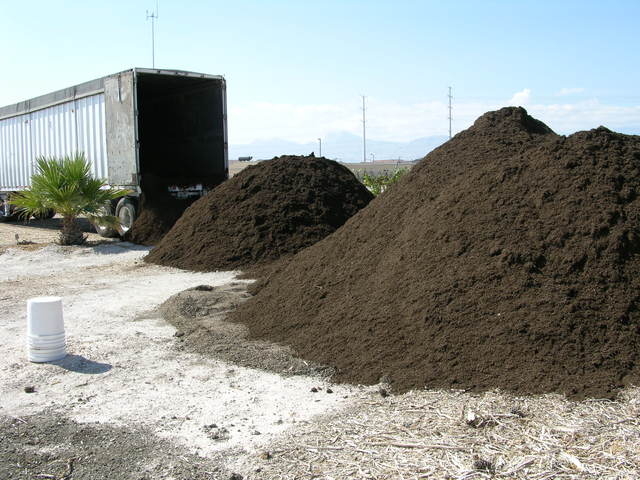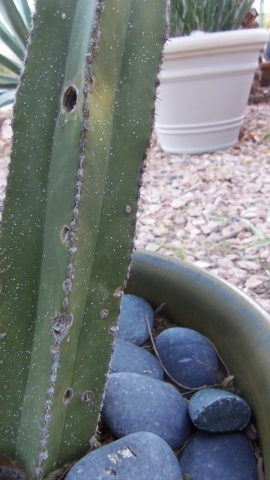Stick with the basics when amending soil
Q: What should I use to amend raised beds? My beds need to be rejuvenated. Sulfur, rock dust, chicken manure, worm castings — I am not sure which ones to use or to use them all.
A: There is a lot of hype on the Internet regarding soil amendments. I can understand why it’s confusing. Sulfur, rock dust, coconut coir, worm castings, chicken manure all make promises of miracles.
Stay with the basics. Amend your soils with compost each year, and your raised beds will be productive every year. The best quality compost is rich in nutrients, consistently black or dark brown in color and a pleasing aroma. Composts that deviate from these characteristics are poorer in quality.
Compost works best if it is mixed with native desert soils. Many of the subdivisions have extremely poor soils because “fill” was used around the homes rather than soil. In many cases, raised beds filled with soil mixes is the least expensive option to having a garden.
If compost is applied to these soils every year most of these amendments are usually not needed. Adding compost and growing a productive garden helps lower the soil pH so sulfur is usually not needed.
Over a year ago, I tested three different rock dusts in several locations throughout Las Vegas and found no benefit to these additions as long as the garden soil was amended with compost.
The type of compost, whether it is traditional compost or compost made from worms, is up to you and your personal preference. Certainly, if you sleep better at night by adding these amendments to your raised beds, by all means apply them. They will not hurt anything as long as you don’t apply too much.
Virtually all of the animal manures are effective if they are composted correctly. The only additions I would suggest when first starting off with raised beds are inocula for legumes such as beans and peas.
The type of fertilizers to use are your personal preference; 0rganic fertilizers typically add more to the soil than conventional fertilizers but cost more. However, if your soil is amended properly at the beginning of the season then small amounts of conventional fertilizers would benefit the plants.
Q: My neighbor has a cactus that has these holes on one side. I am hoping you can tell us what is causing this and if this plant is doomed to die.
A: Nothing substantial came to me regarding the holes in your cactus. Generally speaking, these holes can occur from overwatering.
My first suspicion was a bacterial disease that causes holes in some cacti but I don’t think that is the case with yours. Usually this would occur during wet or humid weather. Not if the plant has been dry.
The only thing I can tell you to do is be careful how often you water. Make sure the plant has good drainage. If the hole does not have any soft tissue around it just consider it a temporary thing and not get too excited about it.
Q: I am hoping you can advise me on how to save my rose bushes I planted last spring. I sprayed my them accidentally with a concentrated insecticide that was not diluted. The next morning the leaves looked like wilted spinach and I cried. Will the bushes die? A friend told me I should have applied it to the soil.
A: They will come back. You burned the leaves with the concentrated insecticide. You should see new leaves and growth popping out in a week or so. During this time be careful not to overwater. Water them normally or even less often if they do not have leaves.
Always follow the label directions when applying and don’t listen to friends. Application depends on the insecticide. Some insecticides are root systemic and applied on the soil around the roots and watered in. Others are foliar and applied to the leaves.
You do not know which is which unless you read the label. The label will tell you how to apply it, when to apply and the application rate.
Q: We have a 2-foot tall, 2-year old Meyer lemon tree with 40-50 young blossoms. Shouldn’t some clusters be thinned and if so how?
A: Don’t thin them. In most cases citrus does not need to be thinned. The plant will drop the fruit it cannot support.
It is not like a peach, apple or plum where small fruit must be removed to make way for larger fruit. Just let it be and see how well is sets this year.
My guess is that it will drop most of the blossoms or fruit that it cannot support. It may drop all of them if the tree is too young to support fruit growth and branch growth at the same time.
That being said, sometimes citrus does have too much fruit on a limb. If the fruit is closer than the diameter of a large fruit, start removing some when they are the size of a quarter.
Q: Our backyard is in full sun, gets very windy and has very poor soil. We are landscaping around a new pool and would like a tropical look. We would love to put in a queen palm but we read they may not do well here. Any suggestions for a different palm like Kentia or Foxtail?
A: The queen palm won’t work in your situation. It does not like poor soils, heat, lack of humidity and wind. It is not a good choice for our hot desert climate in general.
Be careful planting palms near a pool. Most people do not like the seeds dropping and the mess it makes.
The only palm that stays small and hearty for our area is the windmill palm. The pygmy date palm is a possibility but it is sensitive to our winter temperatures and may suffer from winter freezing. The Mediterranean fan palm stays short but can get quite large in diameter. Both Kentia and Foxtail palms are not meant for our climate.
There are plenty of plants that give a tropical look to a landscape that are desert adapted and tolerant of our soils. Mesquite, desert bird of paradise, flax, ornamental grasses, canna lilies, rose of Sharon, crape myrtle, gold dust plant (shade), papyrus, nandina, mock orange, cats claw vine, can be used.
Tropical looking landscapes should be densely planted and designated as a high water use area. Use compost and wood chip surface mulches that won’t blow easily to improve our soils and their growth.
Q: I lost two fruit trees this winter because of an irrigation problem. I would like to replace them with 4-in-1 pluot and plum tree. I’m hoping it’s not too late to plant.
A: It is not too late to plant fruit trees in containers, but it is too late to plant them bare root or sold in packages.
I am not a big fan of fruit trees that have more than one variety on the same tree. In a few years the more aggressive varieties dominate and kill the weaker varieties. In a very short time the tree is dominated by one or two varieties instead of four.
I prefer separate trees planted very close to each other and managed as one tree. I would plant these trees about 12 to 18 inches apart, one on the east side of a large hole and the other on the west.
In the case of pluots and plum, the plum tree should be a Santa Rosa which is a good pollinator for pluots. Pluots are self-pollinating in our climate but having a Santa Rosa plum tree close by helps with fruit set and increases yield.
Two rules should be followed when planting trees close together. Never let them grow back into each other and keep them both pruned and trained to the same size.
Bob Morris is a horticulture expert living in Las Vegas and professor emeritus for the University of Nevada. Visit his blog at xtremehorticulture.blogspot.com. Send questions to Extremehort@aol.com.





























